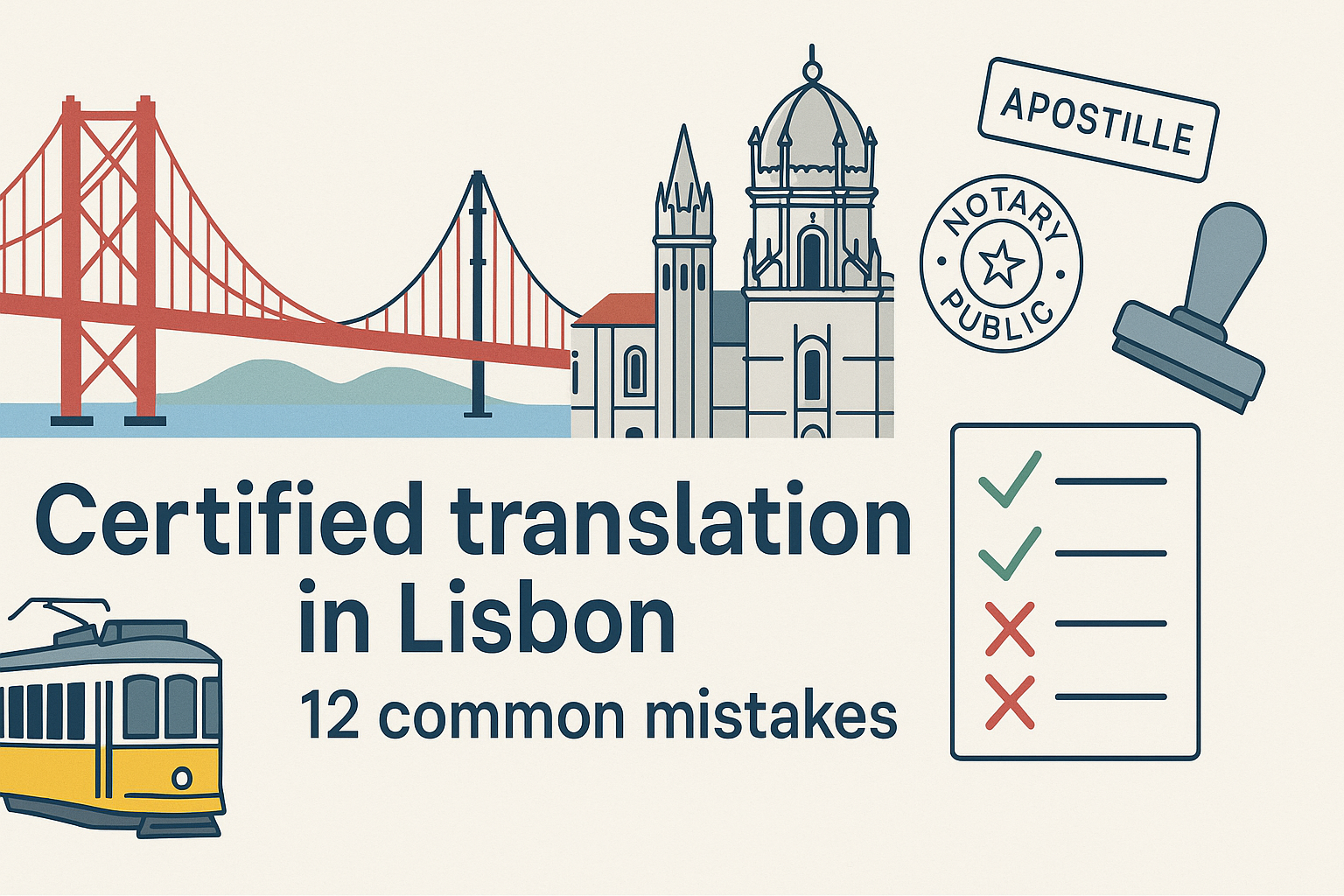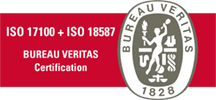Certified translation in Lisbon: 12 common mistakes (and how to avoid them)
Certified translation in Lisbon is simple—if you know the rules. Below are the pitfalls that delay approvals and how to get it right the first time.

Table of Contents
12 common mistakes
Mistake #1 — Assuming “sworn” = “certified” everywhere
Across countries, “sworn,” “certified” and “notarised” aren’t interchangeable. In Portugal, a certified translation is produced by a professional translator and the translator’s signature is certified before a lawyer or notary. In Spain or Brazil, “sworn” can refer to a specific government-authorised translator. When planning a certified translation in Lisbon, confirm the receiving body’s wording and acceptance criteria up front. Our page on Certified Translations explains how we prepare the package for domestic and cross-border use. (m21global.com)
Lisbon scenario: when “sworn” requests appear
Sometimes embassies or universities use templates mentioning “sworn” translators. For Portugal, we align the request with the legally valid format—translator’s declaration plus notarisation—and, if needed, an Apostille for use abroad. See our ISO 17100 certification and the Legal Translation service for how we document chain-of-custody and legalisation steps. (m21global.com)
Mistake #2 — Skipping the Apostille question
If the translation will be used outside Portugal, you may need the Hague Apostille on the notarial act that certifies the translator’s signature. The competent authorities for Apostilles are designated under the HCCH 1961 Convention—check Portugal’s entry before you decide sequencing. We verify this during intake and advise whether the Apostille is required for your destination country. (See HCCH authorities list and Portugal’s details for reference.) (hcch.net)
Mistake #3 — Using non-native or single-linguist workflows
A certified translation is still only as strong as the translation itself. Avoid one-person, non-native routes. ISO 17100 requires a translator and an independent reviser with documented qualifications. Our Translation Services page outlines PRO (two-linguist) vs VALUE paths and when each is appropriate. When risk is high—visas, court filings, tenders—choose the PRO workflow. (m21global.com)
Mistake #4 — Missing page, stamp or signature in the source
Authorities often reject files when a page of the original is missing, stamps aren’t visible, or signatures are cropped. Provide complete, legible scans or the physical document. If we detect gaps, we’ll pause and request a rescan; otherwise the certification may not reflect the full original. For complex layouts, we handle formatting through Technical Translation and DTP so the translated bundle mirrors the source. (m21global.com)
Mistake #5 — Unclear purpose, audience or acceptance rules
An embassy may accept a certified translation in English; a Portuguese registry might require Portuguese. Start with purpose and audience, then confirm acceptance rules on the receiving side. The IRN explains who may certify translations in Portugal (notary, registry official, lawyer, solicitor, chamber of commerce) and that the translator declares fidelity under oath—useful when briefing stakeholders. We include that guidance in quotes and cover letters. (IRN)
Mistake #6 — Wrong local terminology in exhibits
Annexes like criminal record extracts, corporate certificates or diplomas contain terms with specific local equivalents. Mistranslating “certidão” or “cartório” can cause questions. Our Ongoing Training and Continuous Improvement programmes keep glossaries current and reduce rework across projects. (m21global.com)
Mistake #7 — Hoping DTP “can wait”
If the receiving body expects the translation to replicate tables, seals and page breaks, plan DTP early. Our team can paginate complex files so that the notarised pack looks professional and complete. Details are covered on Translation Services under DTP/graphics. (m21global.com)
Mistake #8 — No glossary or reference pack
Provide previous translations, spellings of names, or transliteration rules before we start. This avoids amendments after certification. For recurring needs, we maintain project glossaries and update them as part of our 12 Pillars and “Zero Errors, Total Satisfaction” commitment. (m21global.com)
Mistake #9 — Choosing the cheapest “online” option
Low prices usually mean single-linguist output, no second-person review and weak documentation. If an error forces re-certification, you lose time and money. Our guide on professional translation services explains how to compare providers and what “acceptance-ready” should include. (m21global.com)
Mistake #10 — Ignoring legal translation expertise
For court filings, contracts, powers of attorney and corporate documents, legal context matters. A certified translation in Lisbon should also read as a legal translation, not just a literal one. Learn how we pair certification with subject-matter rigour on our Legal Translation page and practical blog guides. (m21global.com)
Mistake #11 — Last-minute bookings for tight deadlines
Notarisations, Apostilles and couriers add calendar time—especially around holidays. Tell us your hard deadline and destination country so we can stage certification and, if necessary, Apostille. When speed is critical, our PRO workflow scales with multiple linguists while keeping a single reviser in charge, as described under our “Zero Errors” commitment. (m21global.com)
Mistake #12 — Not validating acceptance before couriering
Before we ship the certified pack, we can email scans to the receiving office for a quick “looks good” reply. This avoids costly re-runs. If they require Apostille placement on the notarial page, we’ll handle that according to HCCH guidance and local court practice. See the HCCH page to confirm Portugal’s competent authorities. (hcch.net)
FAQ
Q1. What exactly is included in a certified translation in Lisbon?
A certified translation comprises three parts: the original text, the translated text and a signed statement in which the translator declares, under oath, that the translation is faithful to the original. In Portugal, the translator’s signature is then certified by a lawyer or notary. This creates a legally recognisable bridge between the two language versions suitable for administrative and judicial proceedings.
When the translation is intended for use abroad, some jurisdictions also require an Apostille on the notarial act. We confirm requirements for the destination country at quote stage and advise on sequencing: translation + notarisation first, Apostille second, then courier. That way, you receive a single, complete bundle that meets the target authority’s expectations. (m21global.com)
Q2. When do I need an Apostille for a certified translation from Portugal?
You need an Apostille when the translation (or the notarial certification of the translator’s signature) must be recognised in another country that is party to the 1961 Hague Convention. The Apostille verifies the authenticity of the public act so the foreign authority can trust the certification without further legalisation.
In practice, we ask two questions: where will the document be presented, and what do their written rules say? Based on that, we obtain the Apostille from the competent Portuguese authority and attach it to the notarial page. We also check if the receiving body wants the Apostille on the source document instead—some do. This validation prevents back-and-forth after dispatch. (hcch.net)
Q3. How long does a certified translation in Lisbon take?
Timelines depend on wordcount, formatting and the steps required after translation (notarisation, Apostille, courier). Small personal documents often complete within 1–2 working days for translation and review, with certification arranged right after. Complex files—multi-page contracts, academic transcripts with tables—take longer because they require desktop publishing and a stricter legal review.
We’ll give you a clear plan at intake: production slot, revision window, certification appointment and (if needed) Apostille scheduling. Our Translation Services page outlines standard vs urgent pathways, both backed by ISO 17100 processes to keep quality predictable under pressure. (m21global.com)
Q4. How do you ensure legal accuracy, not just “literal” accuracy?
First, we assign a legal specialist native to the target language. Second, a separate reviser (also qualified) reviews the work, as required by ISO 17100. Third, we validate terminology using client glossaries and public references. Finally, we compile a certification pack with the translator’s sworn declaration for the notary or lawyer.
This layered approach is documented across our Legal Translation and Continuous Improvement pages and reinforced by our Ongoing Training programme so lessons learned benefit future projects. (m21global.com)
Links
- Internal:
- Certified Translations — overview (EN) → https://www.m21global.com/en/translation-services/certified-translations/
- Legal Translation — service page (EN) → https://www.m21global.com/en/translation-services/legal-translation/
- Technical Translation — service page (EN) → https://www.m21global.com/en/translation-services/technical-translation/
- Translation Services — workflows & DTP (EN) → https://www.m21global.com/en/translation-services/
- ISO 17100 certification — how we comply (EN) → https://www.m21global.com/en/iso-17100-certification-elevating-quality-standards/
- Continuous Improvement — PDCA in practice (EN) → https://www.m21global.com/en/continuous-improvement/
- Ongoing Training — specialisation (EN) → https://www.m21global.com/en/ongoing-training/
- The 12 Pillars — QA culture (EN) → https://www.m21global.com/en/the-12-pillars-of-m21global/
- External:
- IRN (Instituto dos Registos e do Notariado) — Tradução de documentos → https://irn.justica.gov.pt/traducao-de-documentos
- HCCH — Apostille Convention authorities list → https://www.hcch.net/en/instruments/conventions/authorities1/?cid=41
- HCCH — Portugal competent authority (detail) → https://www.hcch.net/en/states/authorities/details3/?aid=270

